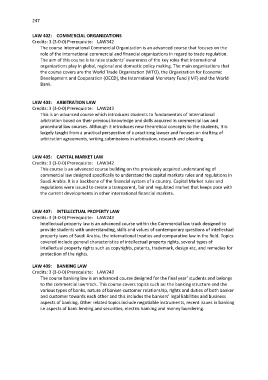Page 248 - University Bulletin
P. 248
MATH103 Descriptive Geometry
Credits: 3 (3,0,0) Prerequisites: None
the course is an introduction to the basic concepts of geometry in three-dimensional space for
students studying Interior design (Architecture) majors. Topics include Euclidean geometry of
points, distances, vectors, scalar product of vectors, projection of vector on another, lines in the
3-dimensional space, parallel and orthogonal lines, angle between two lines, intersection between
two lines, planes in terms of point and normal vector,intersections between pairs of planes,
parallel and orthogonal planes, intersection between plane and line,sphere and cylinders, the
relations among such studied geometric shapes. These topics will be supported by examples.
MATH111 Calculus I
Credits: 3 (3,1,0) Prerequisites: None
This course introduces the students to various topics such as the concept of limits, continuity of
functions, formulas of differentiation, and Techniques of differentiation. Also, applications of
derivatives are introduced such as: extrema and mean value theorems, graph sketching, and
optimization.
MATH113 Calculus II
Credits: 3 (3,1,0) Prerequisites: MATH111
This course introduces various topics such as the concept of antiderivatives, integrals (definite and
indefinite), the fundamental theorem of calculus and applications of definite integrals to find area,
volume, arc’s length and surface area. Furthermore, the course continues in another direction
covering the concept of sequences and infinite series.
MATH115 Differential Calculus
Credits: 3 (3,0,0) Prerequisite: None
An introductory course focusing on fundamental concepts and techniques of differential calculus.
Students explore limits, derivatives, and their applications, learning to evaluate limits
algebraically, graphically, and using limit laws. Through methods like the limit definition of
derivatives, students compute derivatives of algebraic, trigonometric, exponential, and
logarithmic functions. Problem-solving skills are honed as students apply differentiation
techniques to analyze and solve real-world problems, including finding tangent lines, determining
critical points, and solving optimization problems. Concepts of continuity and the Intermediate
Value Theorem are introduced, providing a solid foundation for further study in calculus and
applications in various fields such as economics, and the natural sciences.
MATH117 Integral Calculus
Credits: 3 (3,0,0) Prerequisite: MATH115
This course delves into the study of integrals and their wide-ranging applications in mathematics
and real-world scenarios. Beginning with the foundational concepts of integrals and the
fundamental theorem of calculus, students will explore various techniques of integration and their
practical implications. The course will cover topics including areas and distances, definite and
indefinite integrals, substitution rules, and applications of integration in areas, volumes, work, and
average value computations. Advanced techniques such as integration by parts, trigonometric
integrals, and partial fraction decomposition will be introduced to tackle more complex problems.
Further applications of integration, such as finding arc length and surface area of revolution, will
also be explored.
236 PSU UNDERGRADUATE BULLETIN

